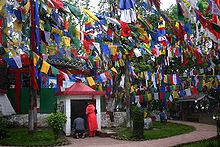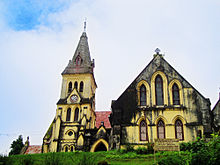- Culture of Darjeeling
-
 St. Andrew's Church, Darjeeling: During snowfall
St. Andrew's Church, Darjeeling: During snowfall
 Colourful Buddhist prayer flags around Mahakal Temple at Observatory Hill, Darjeeling.
Colourful Buddhist prayer flags around Mahakal Temple at Observatory Hill, Darjeeling.
The culture of Darjeeling, India, is quite diverse. Apart from the major Hindu religious festivals like Diwali, Christmas, Dussera, Holi, Ram Navami etc., the diverse ethnic populace of the town celebrates several local festivals. The Tibetan ethnic groups like the Lepchas, Bhutias, Gurungs, and Tamangs celebrate new year called Losar in January/February, Maghe Sankranti, Chotrul Duchen, Buddha Jayanti, and Tendong Lho Rumfaat, to name a few, which provide the "regional distinctness" of Darjeeling's local culture from the rest of India. Darjeeling Carnival, initiated by a civil society movement known as The Darjeeling Initiative, is a ten day carnival held every year during winter that especially portrays the rich musical and cultural heritage of Darjeeling Hills as its central theme.[1]
A popular food in Darjeeling is the momo, a steamed dumpling containing either mutton, pork, beef or vegetables cooked in a doughy wrapping served with a watery vegetable soup and spicy tomato sauce/chutney. Wai-Wai is a favorite packaged snack of Darjeeling hills comprising noodles which are eaten either dry or with soup. Churpee, a kind of hard cheese made from cow or yak's milk is another popular mini-snack that is both nutritious and a pastime. A form of noodle called thukpa, served with soup and vegetables, is extremely popular in and around the hills of Darjeeling. In addition, there are a number of restaurants offering a variety of traditional Indian, Continental and Indian Chinese cuisine to cater to the tourists. Tea is the most popular beverage, procured from the famed Darjeeling tea gardens, as well as coffee. Chhang and tongba are local alcoholic beverage made from millet.
Colonial architecture characterizes many buildings in Darjeeling; several mock Tudor residences, Gothic churches, the Raj Bhawan (Governor House), Planters' Club and various educational institutions are examples. Buddhist monasteries showcase the pagoda style architecture. Darjeeling is regarded as a center of music and a niche for musicians and music admirers. Singing and playing musical instruments is a common pastime among the resident population, who take pride in the traditions and role of music in cultural life.[2] Western music is popular among the younger generation, and Darjeeling is a major centre of Nepali rock music. Prashant Tamang the winner of Indian Idol 3 is a resident of Darjeeling. Cricket and football are the most popular sports in Darjeeling. An improvised form of ball made of rubber garters is often used for playing in the steep streets.
Some notable places to visit include the Tiger Hill, the zoo, monasteries and the tea gardens. The town attracts trekkers and sportsmen seeking to explore the Himalayas, serving as the starting point for climbing attempts on some Indian and Nepali peaks. Tenzing Norgay, one of the two men to first climb Mount Everest, spent most of his adult life in the Sherpa community in Darjeeling. His success provided the impetus to establish the Himalayan Mountaineering Institute in Darjeeling in 1954. In the Tibetan Refugee Self Help Center, Tibetan crafts like carpets, wood and leather work are displayed. Several monasteries like Ghum Monastery (8 km or 5 miles from the town), Bhutia Busty monastery, Mag-Dhog Yolmowa preserve ancient Buddhist scripts.
See Also
References
- ^ Chattopadhyay, S.S. (December 2003). "The spirit of Darjeeling". Frontline 20 (25). http://www.hinduonnet.com/fline/fl2025/stories/20031219000306600.htm. Retrieved 2006-05-01.
- ^ Rasaily DP, Lama RP. "The Nature-centric Culture of the Nepalese". The Cultural Dimension of Ecology. Indira Gandhi National Centre for the Arts, New Delhi. http://ignca.nic.in/cd_07011.htm. Retrieved 2006-07-31.
Categories:- Darjeeling
- Culture of West Bengal
- Culture by Indian city
Wikimedia Foundation. 2010.

